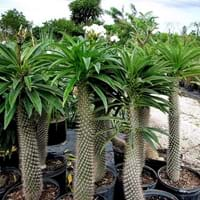Life Span
Perennial
Perennial
Type
Fruit
Cactus or Succulent, Ornamental Plants, Perennial
Origin
Eastern Asia
Madagascar
Types
Actinidia arguta, Actinidia giraldii, Actinidia hypoleuca
P. ambongense P. baronii P. bicolor P. bispinosum P. brevicaule P. cactipes P. decaryi P. densiflorum P. eburneum P. geayi P. gracilius
Habitat
Dappled Shade, open Woodlands
Rocky areas, Tropical areas
USDA Hardiness Zone
3-8
9-12
Sunset Zone
1a, 1b, 2a, 2b, 3a, 3b, 4, 5, 6, 7, 8, 9, 14, 15, 16, 17, 18, 19, 20
H1, H2, 13, 21, 22, 23, 24
Habit
Vining/Climbing
Upright/Erect
Flower Color
White, Ivory
White
Flower Color Modifier
Bicolor
Not Available
Fruit Color
Green, Yellow green
Gray Green, Tan
Leaf Color in Spring
Green, Dark Green
Green, Dark Green
Leaf Color in Summer
Dark Green
Green, Dark Green
Leaf Color in Fall
Dark Green
Dark Green
Leaf Color in Winter
Light Green
Not Available
Leaf Shape
Oval
Long Narrow
Plant Season
Spring, Summer, Fall
Spring, Summer, Fall, Winter
Sunlight
Full Sun, Partial Sun
Full Sun
Growth Rate
Medium
Medium
The pH of Soil
Neutral
Acidic, Neutral, Alkaline
Soil Drainage
Well drained
Well drained
Bloom Time
Spring, Late Spring, Early Summer
Late Spring, Early Summer, Summer
Tolerances
Shade areas
Drought
Where to Plant?
Ground, Pot
Container, Ground, Pot
How to Plant?
Grafting, Stem Cutting
Seedlings, Stem Cutting
Plant Maintenance
Low
Medium
Watering Requirements
Average Water Needs, Requires regular watering
Drought Tolerant, Reduce watering in winter
In Summer
Regular watering required
Lots of watering
In Spring
Moderate
Moderate
In Winter
Average Water
Average Water
Soil pH
Neutral
Acidic, Neutral, Alkaline
Soil Type
Loam
Loam, Moist, Sand, Well drained
Soil Drainage Capacity
Well drained
Well drained
Sun Exposure
Full Sun, Partial Sun
Full Sun
Pruning
Remove damaged leaves, Remove dead branches, Remove dead leaves
Prune in winter, Prune to stimulate growth, Remove damaged leaves, Remove dead branches, Remove dead leaves
Fertilizers
Apply 10-10-10 amount, fertilize twice a year
All-Purpose Liquid Fertilizer, Fertilize in early spring, fertilize in early summer
Pests and Diseases
Botrytis head rot, Japanese Beetles, Leaf Rollers, Nematodes, Phytophthora, Root rot, Sclerotinia blight, Spider mites, Thripes
Aphids, Dry root rot
Plant Tolerance
Shade areas
Drought
Flower Petal Number
Single
Single
Fragrant Bark/Stem
No
Not Available
Foliage Texture
Medium
Bold
Foliage Sheen
Glossy
Glossy
Attracts
Cats
Not Available
Allergy
Not Available
poisonous if ingested, Toxic
Aesthetic Uses
Cottage Garden
along a porch, deck or patio, Beautification, Borders, Showy Purposes
Beauty Benefits
Not Available
Not Available
Edible Uses
Yes
Not Available
Environmental Uses
Shadow Tree
Air purification
Medicinal Uses
Antioxidants, Fiber, Folate, Rich in Potassium, Vitamin C
Not Available
Part of Plant Used
Fruits
Not Applicable
Other Uses
Grown for shade
Decoration Purposes, Showy Purposes
Used As Indoor Plant
No
Sometimes
Used As Outdoor Plant
Yes
Yes
Garden Design
Edible, Feature Plant, Vine
Container, Feature Plant, Mixed Border, Rock Garden, Wall, Tropical
Botanical Name
ACTINIDIA arguta
PACHYPODIUM lamerei
Common Name
Hardy Kiwi
Madagascar Palm, Club Foot
In Hindi
हार्डी कीवी
Madagascar palm
In German
Hardy Kiwi
Madagaskarpalme
In French
kiwai
Pachypodium de Madagascar
In Spanish
kiwi hardy
Palma de Madagascar
In Greek
σκληραγωγημένα ακτινίδια
Pachypodium
In Portuguese
kiwi Hardy
Palmeirinha-de-madagáscar, Palmeira-de-madagáscar
In Polish
hardy kiwi
Pachypodium
In Latin
Hardy kiwi
Mandacaru
Phylum
Magnoliophyta
Magnoliophyta
Class
Magnoliopsida
Dicotyledonae
Order
Theales
Gentianales
Family
Actinidiaceae
Apocynaceae
Genus
Actinidia
pachypodium
Clade
Angiosperms, Asterids, Eudicots
Angiosperms, Asterids, Eudicots
Tribe
Not Available
Malouetieae
Subfamily
Actinidiaceae
Apocynoideae
Number of Species
Not Available
Season and Care of Hardy Kiwi and Madagascar palm
Season and care of Hardy Kiwi and Madagascar palm is important to know. While considering everything about Hardy Kiwi and Madagascar palm Care, growing season is an essential factor. Hardy Kiwi season is Spring, Summer and Fall and Madagascar palm season is Spring, Summer and Fall. The type of soil for Hardy Kiwi is Loam and for Madagascar palm is Sand while the PH of soil for Hardy Kiwi is Neutral and for Madagascar palm is Acidic, Neutral, Alkaline.
Hardy Kiwi and Madagascar palm Physical Information
Hardy Kiwi and Madagascar palm physical information is very important for comparison. Hardy Kiwi height is 550.00 cm and width 90.00 cm whereas Madagascar palm height is 370.00 cm and width 90.00 cm. The color specification of Hardy Kiwi and Madagascar palm are as follows:
Hardy Kiwi flower color: White and Ivory
Hardy Kiwi leaf color: Green and Dark Green
Madagascar palm flower color: White
- Madagascar palm leaf color: Green and Dark Green
Care of Hardy Kiwi and Madagascar palm
Care of Hardy Kiwi and Madagascar palm include pruning, fertilizers, watering etc. Hardy Kiwi pruning is done Remove damaged leaves, Remove dead branches and Remove dead leaves and Madagascar palm pruning is done Prune in winter, Prune to stimulate growth, Remove damaged leaves, Remove dead branches and Remove dead leaves. In summer Hardy Kiwi needs Regular watering required and in winter, it needs Average Water. Whereas, in summer Madagascar palm needs Lots of watering and in winter, it needs Average Water.





